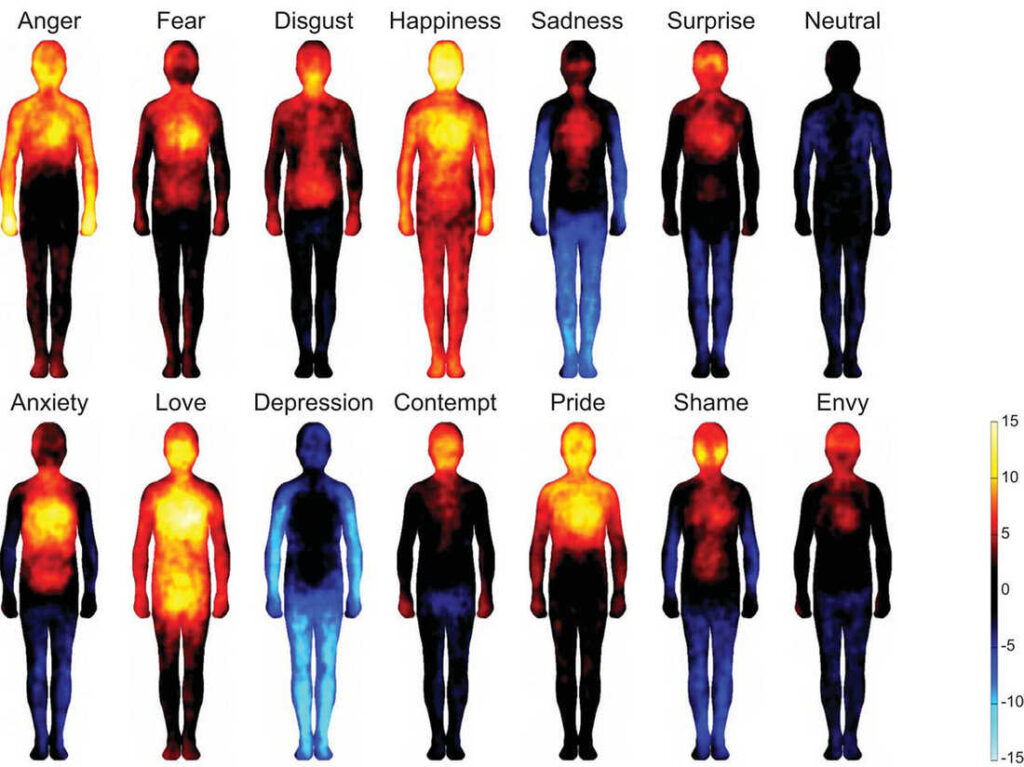Because we all learn from early childhood that our thinking occurs in our brain, you may believe that how you emotionally feel is also generated there. In fact, this is merely an illusion created by your intelligent thinking. Although emotions are typically induced by the brain, the reality is that all our pleasant or unpleasant feelings are ultimately generated by our body. Scientists from Aalto University in Finland have created the beautiful map shown above, which demonstrates where different emotions are generated inside us. If you understand better how this mechanism works, you can gain much more conscious control over your emotional states.
How Are Your Stressful or Pleasant Feelings Exactly Created?
If you begin to pay attention to where you exactly feel your emotions you can observe that in the middle of your head you barely feel anything at all.

In fact, all your feelings arise elsewhere in you. When you feel stressed, in certain parts of your body muscles are getting tensed and some nerve sensors are stimulated to give rise to your unpleasant feelings. When you feel calm and comfortable certain muscles are getting relaxed and pleasant signals are sent from nerve sensors in your body towards your brain. This is why you may experience sorrow as tense feelings in your chest and worrying may cause cramps in your belly. On the contrary, when you feel pleasant in the presence of a beloved person muscles in your body relax. As warm blood starts to flow more freely in your veins, it will give rise to your warm, ‘homy’ feelings.
Because you also have muscles and nerves all over your face, in your neck, and in your throat, you may feel many of your emotions as unpleasant tension or joyful relaxation manifesting on your head too. However, upon closer observation, you will notice that none of those feelings originate in the middle of your brain.
Why Are Your Emotions Generated By Your Body Instead of Your Brain?
You may logically ask yourself why the creation of your emotions is delegated to your body and not happening in your brain. The answer may be surprising, but it is very simple. In the human brain, there are no muscles or pressure-sensitive receptors that could give rise to tense and unpleasant or relaxed and pleasant feelings. Therefore, the brain itself cannot experience pain either. This is the reason why brain surgeries are often performed without anaesthesia, while keeping the patients awake.

The lack of your brain’s ability to give rise to feelings in itself also explains why in most ancient civilizations, people believed that the soul resides in the body, often associating it with places like the heart. They did not understand the function of the brain, but observed correctly that most of our emotions are felt in places inside our body.

In ancient Egypt they removed the brain of mummies, because they thought it to be a completely useless organ making only the preservation difficult. However, they preserved the heart very carefully because they believed it was essential for the survival of the soul.
The reason why our feelings arise in our bodies and not inside our brains also has a fascinatingly simple evolutionary explanation. Animals had already developed nerves inside their bodies before they developed brains. Therefore, they could feel stress and relaxation long before they had a brain to think about it.

Snails, for example, still don’t have brains, yet they can clearly show states of stress and relaxation. Because our nervous system already expressed emotions in our bodies before we had sophisticated brains, it was unnecessary to develop a mechanism to generate feelings for our emotions directly inside our brain too.
Learn to Use Your Sense of Interoception to Develop a Deeper Understanding of How Your Emotions Are Produced in Your Body
If you want to understand better how your emotions are expressed by your body, at first, you have to learn to feel more accurately where they arise. Interoception is the awareness of your internal bodily sensations. You can develop it to a higher level by mindfully observing yourself in different emotional states.

You can use the map of bodily emotions to identify the exact places inside yourself where you feel stress and tension, or relaxation and pleasantness in various emotional states. The colors represent increased or decreased feelings in different regions of the body. For example, love is an intense, warm, energetic feeling experienced both on the head, and all over the body. Anger is a fiery, tense feeling in the head, arms, and upper body, but it does not manifest in the lower body and legs. Depression is experienced as a feelingless state in the central body and as negative, draining energy in the limbs.
Learn to Gain Control Over Your Emotions by Inducing Similar or Opposite Feelings in the Nerves and Muscles Where They Are Manifested
You can increase your positive or dampen your negative emotions by consciously inducing similar or opposite feelings in your body in the areas where they arise. When you feel pleasant and calm you can relax your muscles in your body further and you will feel even more pleasant and calm. This is obvious and requires no special skills to practice. When you experience tense, stressful feelings, you can dampen them by consciously inducing relaxation in the areas of your body where you experience them. It is a bit less obvious how to do it, but if you understand the principles and keep practicing a couple of the following methods, you will be surprised at how easily it can be learned and how powerful the effects of these practices can be on how you feel.
Controlling Stress by Inducing Relief and Relaxation in the Muscles and Nerves Where Your Stress Manifests Itself
Imagine you are worrying and therefore you feel painful cramp in your belly. Your brain sends signals through your nervous system to put the muscles there on constant tension and trigger some nerves that give rise to painful sensations there. Now you can apply a simple method to create relaxation in the constantly tensed muscles and nerves in your belly, and you will see that your stressful feelings will also dampen. If you start to stretch the muscles in your belly, you will feel at first even more tension there. However, when you finally stop stretching, a pulse of intense relaxation will travel from the nerves there back to your brain.

If you repeat the stretching multiple times the repeated pulses of relaxation will give you more and more relief, cancelling out the otherwise permanent painful tension in your belly. You can do similar stretching exercises all over your body from your toes to your head to achieve similar effect. If you practice enough, you can learn to remove all tense feelings caused by stressful emotions from your body this way. All types of intense physical exercises that involve cyclic stretching and relaxation of your muscles can have similar effects. This is the reason why running, swimming, or engaging in power exercises are so good for your general mental well-being.
Using Your Breathing Muscles Around Sensitive Nerves in Your Chest to Create More Relaxation or to Positively Energize Yourself
Your breathing muscles, and some sensitive nerves in your chest are also playing a key role in the creation of stressful or relaxed feelings. While concentrating strongly or under stress, people tend to stop breathing continuously and start breathing irregularly. When feeling sad or depressed we tend to breath shallowly and sigh once in a while when we run out of air. In case of panic, however, the opposite happens. People may start to breathe rapidly, which is called hyperventilation. All these irregular breathing patterns lead to unpleasant feelings.
Fortunately, you can consciously change your breathing pattern at any time. It is also a powerful tool to control your negative emotions. Consciously keeping a deep, slow, relaxed breathing pattern can counteract stress reactions and calm you down. However, there are even more ways to use your breathing muscles in order to stimulate nerves in your chest that can bring you deep relaxation.

When you exhale slowly, relaxing your breathing muscles, nerve signals of pleasant relaxation are sent from the so-called ‘phrenic nerve’ in your chest to your brain and other parts of your body. As a result, neurochemicals like acetylcholine, GABA and serotonin are released in your nervous system, slowing down your heartbeat and removing other, stress-related neurochemicals from your body. Therefore, if you begin to follow a breathing pattern where you slow down your exhalations to take at least two or three times longer than your inhalations, you can rapidly reduce your stressful feelings and make yourself relaxed. There are many relaxing breathing techniques based on this neurologic phenomenon. The famous ‘OM’ om chanting of Buddhist monks is actually also such a breathing exercise bringing its practitioners into an exceptionally calm state of mind.
When you feel low on energy the so called “breath of fire” yoga exercise can rapidly energize you and rise your mood and motivation. This practice involves relaxing the upper chest and performing forceful exhalations followed by passive inhalations. It keeps the upper breathing muscles relaxed, while giving a revitalizing massage to your belly and your organs in that area.
Stress After and During Exercising
Stretching and breathing exercises are excellent ways to remove stress and send relieving signals to your brain. However, if you cannot stop creating negative thoughts in your mind, your stressful feelings will likely return at some point. Therefore, if your stress is induced by serious mental problems, it is important to resolve those underlying mental problems in other ways. Also, if you are thinking stressfully during stretching or breathing exercises, you may cancel out most of the positive effects before they start to occur. Unfortunately, in many yoga studios they talk too much while explaining what people should do, and switch too quickly from one exercise to another during the lessons. Not being able to follow the exercises properly, and not being able to enjoy them, can make you stressed and frustrated. Besides, comparing yourself to other extremely flexible people around you, who do effortlessly things with their bodies which may be impossible for you to replicate, can also make you feel very bad about yourself.

When this happens, your body sends signals of relaxation to your brain, but your brain keeps sending stress signals back to your body. Therefore, in the end, you feel barely better. The frustration will probably lead you to conclude that this does not work for you at all. However, if you begin with easy-to-follow exercises without forcing yourself into impossible positions, you will surely start to feel relaxation and relief in your body at some point. It is also very important to stop comparing yourself to others and always concentrate purely on the joyful sensations that arise from what you are doing during the exercises.